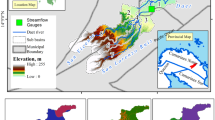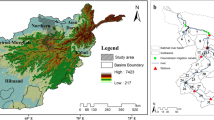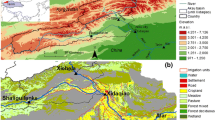Abstract
Agricultural production in the state of Alabama, USA, is mostly rain-fed, because of which it is vulnerable to drought during growing season. Since Alabama receives a significant portion of its annual precipitation during winter months, the goal of this study was to evaluate the feasibility of water withdrawal from streams during winter months for irrigation in the growing season. The Soil and Water Assessment Tool (SWAT) was used to estimate the quantity of water that can be sustainably withdrawn from streams during winter high flow periods. The model was successfully calibrated and validated for surface runoff, base flow, and total stream flow. The stream flows generated by the model at several locations within the watershed were then used to examine how much water can be sustainably withdrawn from streams of various orders (first, second and third). Although there was a considerable year-to-year variability in the amount of water that can be withdrawn, a 16-year average showed that first, second, and third order streams can irrigate about 11.6, 10.3, and 10.6% of their drainage areas, respectively. The percentage of drainage area that can be irrigated was not a function of stream order.






Similar content being viewed by others
References
Alabama Cooperative Extension Service (ACES) (1994) Water harvesting for irrigation: developing an adequate water supply. ANR-827, Alabama Cooperative Extension Service, Auburn, AL. http://www.aces.edu/pubs/docs/A/ANR-0827/ANR-0827.html. Accessed 9 January 2008
Alabama Cooperative Extension Service (ACES) (2008) Alabama state water program. GIS data. http://www.aces.edu/waterquality. Accessed 11 January 2008
Bulter G, Srivastava P (2007) An Alabama BMP database for evaluating water quality impacts of alternative management practices. Transactions of the American Society of Agricultural and Biological Engineers 23(6):727–736
Dougherty M, Bayne D, Curtis L, Reutebuch E, Seesock W (2007) Water quality in a non-traditional off-stream polyethylene-lined reservoir. Journal of Environmental Management 85:1015–1023
Eckhardt K (2005) How to construct recursive digital filters for base flow separation. Hydrological Processes 19(2):507–515
Green WH, Ampt G (1911) Studies of soil physics: Part I. The flow of air and water through soils. Journal of Agricultural Sciences 4:1–24
Green CH, Tomer MD, Di Luzio M, Arnold JG (2006) Hydrologic evaluation of the soil and water assessment tool for a large tile-grained watershed in Iowa. Transactions of the American Society of Agricultural Engineers 49(2):413–422
Hargreaves GL, Hargreaves GH, Riley JP (1985) Agricultural benefits for Senegal River Basin. Journal of Irrigation and Drainage Engineering 108(3):225–230
Kalin L, Hantush MM (2006) Hydrologic modeling of an eastern Pennsylvania watershed with NEXRAD and rain gauge data. Journal of Hydrologic Engineering 11(6):555–569
Lim KJ, Engel BA, Tang EZ, Choi J, Kim KS, Muthukrishnan S, Tripathy D (2005) Automated web-GIS based hydrograph analysis tool, WHAT. Journal of American Water Resources Association 41(6):1407–1416
Lyne V, Hollick M (1979) Stochastic time-variable rainfall-runoff modelling. Institute of Engineers, Australia National Conference Publication 79/10: 89–93
Monteith JL (1965) Evaporation and the environment. In: Fogg GE (ed) The state and movement of water in living organisms. 19th Symposia of the Society for Experimental Biology. Cambridge University Press, London, pp 205–234
Nash JE, Suttcliffe JV (1970) River flow forecasting through conceptual models: Part I. A discussion of principles. Journal of Hydrology 10(3):282–290
Neitsch SL, Arnold JG, Kiniry JR, Williams JR, King KW (2002) Soil and Water Assessment Tool (SWAT) Theoretical Documentation, Version 2000. USDA-ARS Grassland, Soil, and Water Research Laboratory, Temple, TX. www.brc.tamus.edu/swat/. Accessed 1 December 2007
NLCD (2001) National Land Cover Dataset. WWW Document available at www.aces.auburn.edu/waterquality. Accessed December 2007
Peschel JM, Haan PK, Lacey RE (2003) A SSURGO pre-processing extension for the ArcView Soil and Water Assessment Tool (AVSWAT). ASABE Paper No. 032123. ASABE, St. Joseph, MI
Poff NL, Richter B, Arthington AH, Bunn SE, Naiman RJ, Kendy E, Acreman M, Apse C, Bledsoe BP, Freeman M, Henriksen J, Jacobson RB, Kennen J, Merritt DM, O’Keeffe J, Olden JD, Rogers K, Tharme RE, Warner A (2010) The ecological limits of hydrologic alteration (ELOHA): a new framework for developing regional environmental flow standards. Freshwater Biology 55:147–170
Priestley CHB, Taylor RJ (1972) On the assessment of surface heat flux and evaporation using large-scale parameters. Monthly Weather Review 100:81–92
Richter BD, Mathews R, Harrison DL, Wigington R (2003) Ecologically-sustainable water management: managing river flows for ecological integrity. Ecological Applications 13(1):206–224
Richter BD, Warner AT, Meyer JL, Lutz K (2006) A collaborative and adaptive process for developing environmental flow recommendations. River Research and Applications 22(3):297–318
Rochester EW, West MS, Curtis LM (1996) Available irrigation water from small Tennessee Valley streams. Transactions of the American Society of Agricultural Engineers 39(1):25–31
Santhi C, Arnold JG, Williams JR, Dugas WA, Srinivasan R, Hauck M (2001) Validation of the SWAT model on a large river basin with point and nonpoint sources. Journal of American Water Resources Association 37(5):1169–1188
Santhi C, Srinivasan R, Arnold JG, Williams JR (2006) A modeling approach to evaluate the impacts of water quality management plans implemented in a watershed in Texas. Journal of Environmental Modeling and Software 21:1141–1157
Srivastava P, McNair JN, Johnson TE (2006) Comparison of mechanistic and neural network approaches for stream flow modeling in an agricultural watershed. Journal of the American Water Resources Association 42(2):545–563
U.S. Fish & Wildlife Service and Environmental Protection Agency (USFWS and EPA) (1999) Instream flow guidelines for the ACT and ACF basins interstate water allocation formula. Enclosure to letter dated October 25, 1999, from J.H. Hankinson, EPA Regional Administrator, and S.D. Hamilton, USFWS Regional Director, to L. Thomas, ACF Federal Commissioner. 14 pp + appendices
Williams JR (1969) Flood routing with variable travel time or variable storage coefficients. Transaction of ASAE 12(1):100–103
Acknowledgments
The authors wish to acknowledge the funding provided by the National Oceanic and Atmospheric Agency (NOAA) to explore the possibility of increasing irrigation in the state of Alabama, U.S.A. We would also like to thank Dr. Prabhakar Clement, Professor, Civil Engineering, Auburn University, Auburn, AL for his constructive comments on an earlier version of this manuscript.
Author information
Authors and Affiliations
Corresponding author
Rights and permissions
About this article
Cite this article
Srivastava, P., Gupta, A.K. & Kalin, L. An Ecologically-Sustainable Surface Water Withdrawal Framework for Cropland Irrigation: A Case Study in Alabama. Environmental Management 46, 302–313 (2010). https://doi.org/10.1007/s00267-010-9537-8
Received:
Accepted:
Published:
Issue Date:
DOI: https://doi.org/10.1007/s00267-010-9537-8




